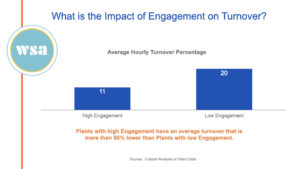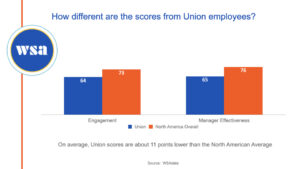In the rapidly evolving manufacturing sector, enhancing employee experience is not just a strategy—it’s a business imperative. In our WSA Monthly Learning Session, Employee Experience Trends in Manufacturing, we were guided by Randy Sterns, an executive consultant at WSA renowned for his strategic expertise in workforce planning. Randy offered actionable engagement strategies tailored for the manufacturing landscape. Let’s distill these insights to uncover how your business can benefit from understanding the latest data.
Insight One: Embracing an Employee-Centric Culture
The shift toward employee-centric cultures is a significant trend. By prioritizing employee well-being and satisfaction, manufacturing companies can see significant retention and productivity gains. A valued and supported workforce is more likely to be engaged, motivated, and committed to achieving organizational goals. At one manufacturing plant, data shows that the most engaged teams have a turnover rate of just 11%, significantly lower than the rates seen in less engaged teams. Implementing comprehensive wellness programs, flexible work arrangements, and recognition initiatives can foster a positive work environment that drives performance.
For example, many organizations now offer flexible work schedules and other financial incentives to retain older employees, who represent a significant portion of the workforce. Such initiatives have proven effective in maintaining a skilled and experienced workforce, ultimately enhancing productivity and reducing turnover.

Insight Two: Leveraging Technology for Enhanced Employee Engagement
Technology is quickly changing the manufacturing sector with tools that can significantly enhance employee engagement. Organizations that are implementing technological innovations, such as real-time feedback systems and digital communication platforms, have seen improvements in employee satisfaction and engagement. These tools enhance transparency, foster collaboration, and create a more responsive and engaged workforce.
Insight Three: Using Continuous Learning and Development to Close Skill Gaps
Addressing workforce gaps through ongoing training and skills development is often a missed opportunity in today’s manufacturing environment. Investing in training not only equips employees with the necessary skills but also demonstrates a commitment to their professional growth. This investment leads to higher employee loyalty, increased innovation, and improved performance.
Companies that partner with local educational institutions and invest in upskilling programs have seen substantial benefits. For instance, organizations working with community colleges to train new employees have successfully closed skill gaps and improved operational efficiency. Additionally, ongoing learning opportunities also serve as a key retention tool, making companies more attractive to both current employees and potential hires.
Insight Four: Promoting Diversity and Inclusion to Drive Innovation and Problem-Solving
A diverse workforce brings a wide range of perspectives and ideas to the table, driving innovative solutions and effective problem-solving to enhance a company’s competitive edge. Embracing diversity and inclusion (D&I) strategies—from inclusive recruitment practices to creating supportive work environments—can significantly improve team problem-solving capabilities and innovation.
Companies that have embraced D&I initiatives reported better team problem-solving capabilities and increased innovation. For example, organizations that support diverse hiring practices and inclusive work environments have seen a notable increase in creativity and overall team performance.
Insight Five: Navigating Union Activity
Union activity remains a rising trend in the manufacturing landscape. Understanding the concerns and priorities of unionized employees is crucial for maintaining a harmonious workplace. On average, the scores from unionized employees are 11 percentage points lower than the scores from the broader North American employee population. This difference suggests that unionized workers might be less satisfied or have more concerns compared to the general workforce, and they may also be motivated to rate the organization poorly to gain leverage in contract negotiations. By encouraging transparent communication, fostering trust, and working with union representatives, your business can proactively address employee grievances and cultivate a more productive work environment.
An example from our session highlighted a manufacturing company that engaged proactively with union representatives. By promoting open communication and addressing employee concerns, the company maintained a stable and productive work environment, demonstrating the importance of effective union management.

Insight Six: Developing Effective Leaders to Inspire and Motivate Teams
Effective leadership is crucial for inspiring and motivating teams. Leaders who excel in emotional intelligence, communication, and empathetic management create a culture of trust and collaboration. Investing in leadership development programs can transform your workplace, fostering respect and shared goals. This approach drives immediate improvements and ensures sustained success.
The Potential of Employee Engagement
By embracing these comprehensive employee engagement strategies, manufacturing businesses can unlock exceptional outcomes and ensure a motivated and satisfied workforce. Leverage these insights to elevate employee commitment and performance, driving your organization toward sustained success. For a guided look into these trends, watch the recorded Learning Session here.
Explore the entire WSA 2024 Monthly Learning Session schedule here

